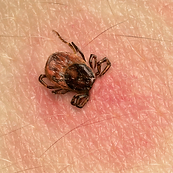Lyme disease/Insect Borne Illness
Lyme disease is a condition caused by the transmission of a spirochete bacteria called Borrelia Burgdorferi via a tick bite.
There is constant debate in Australia about the likelihood and presence of Lyme disease. The claims are that ‘the ticks that carry this bacteria are not native to Australia’. This theory does not account for the numerous other species of Borrelia which have been found in Australian ticks. In 1962 there was also a species of Borrelia (Borrelia Queenslandica) discovered in Echidnas in Australia.
It is suspected that other various species of Borrelia (as well as various other pathogenic organisms transmitted by a tick bite) also cause the same symptoms of Lyme disease. For this reason, the better term in Australia would be ‘tick borne illness’ or ‘insect borne illness’ as it could be politically correct that Borrelia Bergdorferi has not been isolated in Australian ticks. This is not true however for Australian individuals who have contracted Lyme disease while travelling overseas (Borrelia Bergdefori has been found in ticks in the USA, South America, England, France, Germany, Sweden, Asia, Africa and Australasia).
It is also suspected that other insects such as sand flies and mosquitoes may transmit these pathogenic organisms.
The other common co-infections of Lyme disease are:
-
Babesia species
-
Bartonella species
-
Rickettsia
-
Ehrlichia species
-
Anaplasma species
-
Mycoplasma species
-
Relapsing fever
Without investigation, it is hard to know for certain if you have been bitten by a tick. After a tick bite, there are a few early stage signs and symptoms which occur in the following days/weeks including:
-
Erythema Migrans Rash - An estimated 30% of individuals will develop an Erythema Migrans (EM) ‘bulls eye’ rash 3-30 days after a tick bite
-
Flu like symptoms
-
Headaches
-
Fatigue
-
Inability to concentrate and poor memory recall
-
Chills, sweating and fever
-
Sore throat
-
Swollen glands
-
Aching muscles and joints
-
Stiff neck
-
Knee pains
-
Gastrointestinal issues including abdominal pain, diarrhoea, constipation and nausea
-
Tinnitus, vertigo and blurred vision
-
Irritable bladder
Long term signs and symptoms (if left untreated) weeks to months later:
-
Chronic fatigue
-
Headaches
-
Paralysis (usually on one side of the face)
-
Arthritis like pain, commonly affecting the knees
-
Difficulty with memory recall
-
Difficulty concentrating
-
Numbness and tingling
-
Skin rashes
-
Sensitivity to light and sound
-
Development of food sensitivities and multiple chemical sensitivity (MCS)
-
Palpitations, chest pain/tight chest and irregular heartbeat
-
Dizziness
-
Chronic cough
-
Depression and anxiety
-
Floaters in the eyes
-
Twitches
-
Chronic nerve pain
Naturopathic considerations and investigations
Lyme disease/tick borne illness is complex, and not well understood or recognized in Australia. It is common for basic pathology reports to come back as ‘normal’. Further investigations are always warranted in these situations, these may include:
,
-
Comprehensive case taking
-
Investigating your home, workplace and possibly means of travel to assess for possible mould and mycotoxin exposure
-
Investigation other environmental exposures including indoor air quality/pollutants, electromagnetic fields and radiation and other toxicants
-
Investigating genetic haplotype (HLA DR/DQ)
-
Investigating insect-borne illnesses, stealth pathogens and infections such as epstein-barr virus, Bourellia, Bartonella, Babesiosis (Piroplasmosis), Ehrlichia/Anaplasma, Rickettsia and Mycoplasma
-
Investigating past microbial infections
-
Assessing and correcting nutritional deficiencies such as zinc, quercetin, B12, Vitamin C etc
-
Assessing (and supporting) liver function and detoxification pathways
-
Assess stressors such as exercise, inflammatory diets and work/life balance
-
Assess hormonal imbalances such as cortisol, thyroid and oestrogen
-
Assess digestive health, leaky gut and gut microbiome (which all play a vital role with metabolising histamine and toxins, preventing infection/inflammation, immune regulation and the absorption and assimilation of nutrients)
-
Support energy production, detoxification pathway, mood and the nervous system through careful prescription of nourishing herbs and an anti-inflammatory, low histamine or low FODMAP diet
Lyme disease/tick borne illness sufferers commonly experience unexplained chronic fatigue syndrome, previously diagnosed conditions such as fibromyalgia and multiple chemical sensitivities to environmental chemicals as well as foods. And if exposed to mould and mycotoxins may develop worsening of their symptoms.

Where to next?
We offer a holistic approach to treating CFS by investigating and identifying the root cause and working with a collaborative team of GP’s, psychologists and other health care practitioners.
Book your complimentary discovery consultation to find out how we can help you achieve your health goals today!
